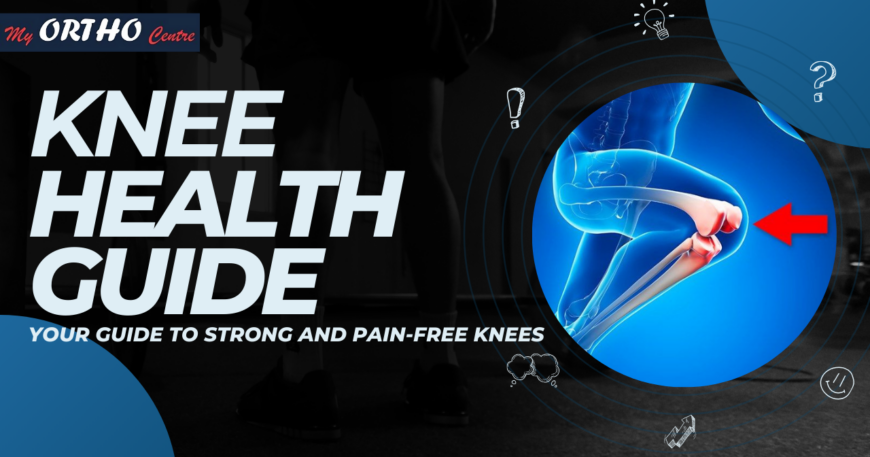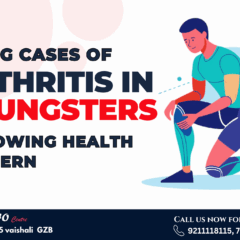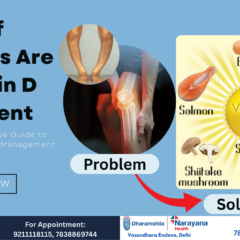
Knee Health : Comprehensive Guide to Pain Prevention and Treatment
Maintaining knee health is crucial for mobility, balance, and overall quality of life. Knee pain can arise from various factors, and knowing how to prevent it, what foods to consume, and the available treatment options can make a significant difference in your well-being. This guide will cover everything from the reasons behind knee pain to advanced treatment options available at My Ortho Centre.
1. Reasons for Knee Pain
Knee pain can stem from several causes, ranging from lifestyle choices to underlying medical conditions. Understanding these reasons is essential for effective prevention and treatment.
- Injuries: Acute injuries such as ligament tears, meniscus injuries, or fractures are common causes of knee pain, particularly among athletes and active individuals. Even minor falls or twists can lead to significant pain.
- Arthritis: Osteoarthritis is the most prevalent form of arthritis affecting the knees. It involves the gradual wear and tear of cartilage, leading to chronic pain and stiffness. Rheumatoid arthritis, an autoimmune condition, can also cause inflammation and pain in the knee joints.
- Overuse: Repetitive movements, especially in sports or jobs that require constant knee bending, can lead to overuse injuries. Conditions such as patellar tendinitis and bursitis are common in individuals with high activity levels.
- Obesity: Carrying excess weight puts additional strain on the knee joints, increasing the risk of osteoarthritis and other degenerative conditions.
- Structural Problems: Issues such as misalignment of the knee or foot, flat feet, or hip problems can cause knee pain due to the uneven distribution of body weight.
2. How to Keep Your Knees Healthy?
Keeping your knees healthy requires a combination of exercise, weight management, and protective practices.
- Regular Exercise: Engage in low-impact exercises like swimming, cycling, and walking. Strengthening exercises for the quadriceps, hamstrings, and calves help support the knee joint and reduce the risk of injury.
- Maintain a Healthy Weight: Reducing body weight can significantly decrease the strain on your knees. Every pound lost reduces the load on the knee joint by four pounds, helping to prevent pain and degeneration.
- Proper Footwear: Wear shoes that provide adequate support and cushioning. Orthotic inserts can also help align the feet and knees properly, reducing stress on the joints.
- Stay Flexible: Incorporate stretching exercises into your routine to maintain flexibility in the muscles and tendons surrounding the knee. Yoga and Pilates are excellent for improving flexibility and balance.
3. Precautions to Keep Your Knees Healthy
Taking preventive measures can go a long way in protecting your knees from injury and pain.
- Warm-Up Before Exercise: Always start with a warm-up to increase blood flow to the muscles and joints, reducing the risk of injury during workouts.
- Avoid High-Impact Activities: Activities like running on hard surfaces or jumping can cause excessive stress on the knees. Opt for low-impact exercises that are gentler on the joints.
- Use Proper Techniques: Whether lifting weights or engaging in sports, using the correct techniques is crucial to avoid unnecessary strain on the knees.
- Take Breaks: If your job or activities involve prolonged knee bending or standing, take regular breaks to relieve the pressure on your knees.
- Listen to Your Body: If you experience knee pain or discomfort, don’t ignore it. Rest, ice, and seek medical advice if the pain persists.
4. Healthy Foods for Knee Joints
Nutrition plays a vital role in maintaining knee health. Certain foods can help reduce inflammation and strengthen the joints.
- Omega-3 Fatty Acids: Found in pumpkin seeds, almonds, eggs, sprouts, and in fish like salmon, mackerel, and sardines, omega-3 fatty acids have anti-inflammatory properties that can help reduce knee pain.
- Calcium and Vitamin D: These nutrients are essential for bone health. Dairy products, leafy greens, and fortified foods provide calcium, while sunlight and fish are good sources of Vitamin D.
- Antioxidants: Foods rich in antioxidants, such as fruits, salad, berries, nuts, and green tea, can help reduce inflammation and protect joint tissues from damage.
- Turmeric: This spice contains curcumin, a compound with powerful anti-inflammatory effects that can alleviate knee pain.
5. Knee Pain Treatment at My Ortho Centre
At My Ortho Centre, we offer a range of treatment options tailored to the specific needs of our patients, from conservative approaches to advanced surgical interventions.
a) Conservative Treatment
Conservative treatments are often the first line of defence against knee pain, especially in mild to moderate cases.
- Physical Therapy: Tailored exercises and stretches designed to strengthen the muscles around the knee, improve flexibility, and reduce pain.
- Medication: Nonsteroidal anti-inflammatory drugs (NSAIDs) can help manage pain and inflammation. Corticosteroids may also be prescribed for more severe cases.
- Bracing: Knee braces can provide support and stability, particularly for patients with ligament injuries or osteoarthritis.
b) Platelet-Rich Plasma (PRP) Therapy
PRP therapy is a regenerative treatment that uses the patient’s own blood to promote healing in the knee joint.
- How It Works: A small amount of blood is drawn and processed to concentrate the platelets, which are then injected into the affected area to stimulate tissue repair and reduce inflammation.
- Benefits: PRP therapy is minimally invasive and can provide relief from chronic knee pain without the need for surgery.
c) Injections
Injections are another non-surgical option for managing knee pain.
- Corticosteroid Injections: These injections can provide quick relief from inflammation and pain, especially in cases of arthritis.
- Hyaluronic Acid Injections: These are used to lubricate the knee joint, improving mobility and reducing pain in patients with osteoarthritis.
d) Surgery
When conservative treatments and injections fail to provide relief, surgical options may be considered.
- i) Partial Knee Replacement:
- Procedure: This surgery involves replacing only the damaged portion of the knee, preserving as much of the natural knee structure as possible.
- Benefits: It’s less invasive than total knee replacement, with a quicker recovery time and more natural knee movement post-surgery.
- ii) Total Knee Replacement:
- Procedure: This involves replacing the entire knee joint with an artificial implant, usually made of metal and plastic.
- Benefits: Total knee replacement is recommended for severe cases of arthritis or knee damage. It provides significant pain relief and improved joint function.
Conclusion
Knee health is an essential aspect of overall well-being, and taking proactive steps can prevent pain and injury. By understanding the reasons behind knee pain, adopting healthy practices, and considering the advanced treatment options available at My Ortho Centre, you can maintain strong, pain-free knees for years to come. Whether you need conservative care or are considering surgical intervention, our team is here to provide expert guidance and treatment tailored to your needs.


